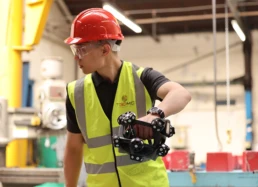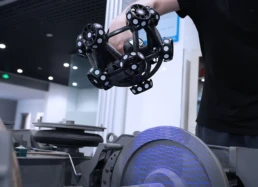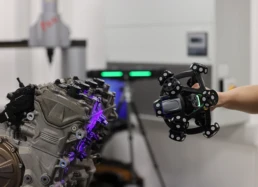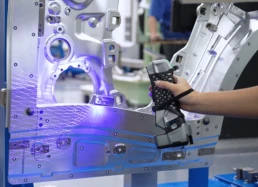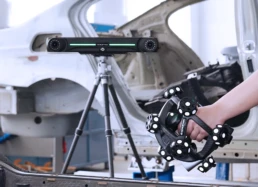Revolutionising Industries with Portable 3D Scanning
In the dynamic world of manufacturing and design, one technology is making waves like never before—portable 3D scanning. With applications across aerospace, automotive, power, and energy, these devices have become game-changers in quality control, reverse engineering, and product development. Gone are the days when bulky 3D scanning equipment tethered operators to a fixed location. Today, handheld 3D scanners provide unprecedented accuracy and flexibility, reshaping how industries capture and utilise 3D data.
The Evolution of Portable 3D Scanning
Portable 3D scanners, particularly handheld models, have significantly evolved over the past decade. Initially, they were limited by size, weight, and technology, but advances in laser technology and software have transformed them into highly efficient and precise tools. Today, these devices are essential in industrial settings, providing the ability to capture intricate details and data with ease.
The importance of portable 3D scanners in modern industry settings cannot be overstated. They offer unparalleled accuracy and operational efficiency, enabling companies to streamline production processes, minimise errors, and accelerate time-to-market. These devices are not just tools; they are strategic assets that enhance competitiveness and innovation.
Understanding Portable Handheld 3D Scanning Technology
Handheld and portable 3D scanning technologies have come a long way in enhancing the capabilities of professionals across various sectors. These scanners employ advanced features like blue light laser technology, which improves precision by reducing interference from ambient light. Cutting-edge software complements the hardware, offering robust data processing and real-time analysis.
Wireless 3D scanners further increase convenience, allowing users to move freely around objects without the hassle of cords. The integration of intuitive interfaces and user-friendly software makes the technology accessible, even to those new to the field. Whether capturing small components or large structures, these professional 3D scanners deliver consistent and accurate results.
Key Benefits of Portable 3D Scanners
Accuracy and Data Precision
Portable 3D scanners are known for their high accuracy and data precision. They capture millions of data points within seconds, ensuring detailed replication of objects. This precision is critical for industries where even a minor deviation can lead to significant setbacks.
Efficiency in Data Capture and Processing
Efficiency is another hallmark of portable 3D scanners. They significantly reduce the time required for data capture and processing, allowing for quick decision-making and iterative design processes. This efficiency translates to faster project completions and shortened development cycles, vital in competitive markets.
Cost-Effectiveness
Industries using portable 3D scanners often find them to be cost-effective solutions. By minimising errors and reducing time-to-market, these scanners help in controlling operational costs. The investment in accurate 3D scanners pays off in improved quality control and reduced material waste.
Industry Applications of Portable 3D Scanners
Aerospace
In the aerospace sector, portable 3D scanners play a pivotal role in enhancing integration and performance. They are used to capture precise dimensions of aircraft components, ensuring they meet rigorous standards and fit seamlessly into larger assemblies. This capability is vital for maintaining safety and performance in aviation.
Automotive
Automotive industries rely on portable 3D scanners for quality assurance and precision dimension capture of vehicle parts. These scanners aid in designing components that meet exact specifications, enhancing performance and safety. Furthermore, they streamline the reverse engineering process, facilitating the reproduction of parts and aiding in restoration projects.
Power & Energy
For the power and energy sectors, accurate evaluation of turbines and other critical equipment is crucial. Portable 3D scanners provide the detailed insights necessary for maintenance and upgrades. They help identify wear and tear, ensuring timely interventions and efficient operation of equipment.
Real-World Successes
Portable 3D scanners have proven their worth in various real-world applications. Industry professionals consistently report successful implementations that enhance their workflow and output.
For example, an aerospace company used a portable 3D scanner to reduce the inspection time of engine components by 50%, leading to faster turnaround times and improved productivity. Another automotive manufacturer utilised scanners to enhance the accuracy of prototype development, resulting in a 30% reduction in design errors.
Testimonials from satisfied clients further attest to the technology’s impact. “The precision and efficiency of our handheld 3D scanner have revolutionised our quality control processes,” says a quality manager from a leading automotive firm. Such endorsements highlight the tangible benefits these devices offer.
Showcasing Innovative 3D Scanning Products
Several cutting-edge products exemplify the capabilities of portable 3D scanners. Devices like the SIMSCAN-E, NIMBLETRACK, and TRACKSCAN SHARP-S are at the forefront, offering varied features to suit different industry needs.
The SIMSCAN-E is known for its lightweight design and high-resolution scanning, perfect for detailed inspections. NIMBLETRACK offers excellent versatility, accommodating a range of applications from small components to large structures. TRACKSCAN SHARP-S is a solution for large scale parts, celebrated for its speed and accuracy.
Elevating Operations with 3D Scanning
The integration of portable 3D scanning technology into industrial workflows offers numerous advantages. By ensuring superior quality control and innovative design capabilities, businesses can drive better performance and profitability. Industries must continue to adapt and adopt these technologies to stay ahead.
For those interested in enhancing their operations with 3D scanning solutions, seeking personalised advice from experts is a beneficial step. The right guidance can help align technology adoption with specific business goals, ensuring a successful transition to more advanced capabilities.



